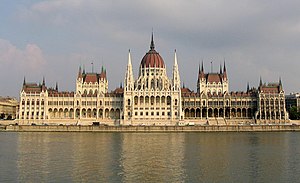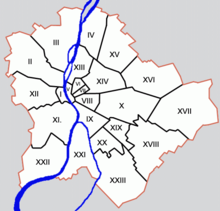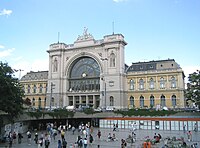Budapest
Budapest | |
|---|---|
| Nickname(s): Paris of the East", "Pearl of the Danube" or "Queen of the Danube | |
 Location of Budapest in Hungary | |
| Country County | Hungary none |
| Government | |
| • Mayor | Gábor Demszky (SZDSZ) |
| Population (2005) | |
| • Total | 1,695,000 |
| Time zone | UTC+1 (CET) |
| • Summer (DST) | UTC+2 (CEST) |
| Website | www.budapest.hu |
Budapest (pronounced ['budɒˌpɛʃt]) is the capital city of Hungary and the country's principal political, cultural, commercial, industrial and transportation center.
Budapest has over 1.7 million inhabitants, down from a mid-1980s peak of 2.1 million. Budapest became a single city occupying both banks of the river Danube with the amalgamation in 1873 of right-bank Buda (Ofen in German) and Óbuda (Old Buda or Alt-Ofen) together with Pest on the left (east) bank. It is the seventh largest city in the European Union.
History
Budapest's recorded history begins with the Roman town of Aquincum, founded around 89 AD on the site of an earlier Celtic settlement near what was to become Óbuda, and from 106 until the end of the 4th century the capital of the province of lower Pannonia. Aquincum was the base camp of Legio II Adiutrix. The area of Campona (today's Nagytétény) belongs to Buda as well. Today's Pest became the site of Contra Aquincum (or Trans Aquincum), a smaller sentry point. The word Pest (or Peshta) is thought to originate from the Bolgar language, (a Turkic language, not related to modern Bulgarian, which is a Slavic language) because at the time of the reign of the Bulgarian Khan Krum, the town was under Bulgar Turk dominion. The area then became a homeland for the Avars and some Slavic peoples.



The area was occupied around the year 900 by the Magyars of Central Asia, the cultural and linguistic ancestors of today's ethnic Hungarians, who a century later officially founded the Kingdom of Hungary. Already a place of some significance, Pest recovered rapidly from its destruction by Mongol invaders in 1241, but it was Buda, the seat of a royal castle since 1247, which in 1361 became the capital of Hungary. The Croats who have been in personal union with the Hungarian Crown for centuries and also accepted Budapest as their capital, still call this city Budimpešta (Croatian or Serbian Budim for Buda and Pešta for Pest).
The Ottoman Empire's conquest of most of Hungary in the 16th century interrupted the cities' growth: Buda and Pest fell to the invaders in 1541. While Buda remained the seat of a Turkish pasha, and administrative center of a whole vilayet, Pest was largely derelict by the time of their recapture in 1686 by Austria's Habsburg rulers, who since 1526 had been Kings of Hungary despite their loss of most of the country.
It was Pest, a bustling commercial town, which enjoyed the faster growth rate in the 18th and 19th century and contributed the overwhelming majority of the cities' combined growth in the 19th. By 1800 its population was larger than that of Buda and Óbuda combined. The population of Pest grew twentyfold in the following century to 600,000, while that of Buda and Óbuda quintupled.
The fusion of the three cities under a single administration, first enacted by the Hungarian revolutionary government in 1849 but revoked on the subsequent restoration of Habsburg authority, was finally effected by the autonomous Hungarian royal government established under the Austro-Hungarian Ausgleich ("Compromise") of 1867; see Austria-Hungary. The total population of the unified capital grew nearly sevenfold in 1840–1900 to 730,000.
During the 20th century, most population growth occurred in the suburbs, with Újpest more than doubling between 1890–1910 and Kispest more than quintupling in 1900–1920, as much of the country's industry came to be concentrated in the city. The country's human losses during World War I and the subsequent loss of more than two thirds of the former kingdom's territory (1920) dealt only a temporary blow, leaving Budapest as the capital of a smaller but now sovereign state. By 1930 the city proper contained a million inhabitants, with a further 400,000 in the suburbs.
Between 20% and 40% of Greater Budapest's 250,000 Jewish inhabitants died through Nazi and Arrow Cross genocide during 1944 and early 1945. [1], [2] Despite this, Budapest today has the highest number of Jewish citizens per capita of any European city.
On January 1, 1950, the area of Budapest was significantly expanded: new districts were formed from the neighbouring cities and towns (see Great-Budapest). From the severe damage during the Soviet siege in 1944, the city recovered in the 1950s and 1960s, becoming to some extent a showcase for the more pragmatic policies pursued by the country's communist government (1947–1989) from the 1960s. Since the 1980s, the capital has shared with the country as a whole in increased emigration (mostly to the agglomeration) coupled with natural population decrease.
Demographic history

- 1800: 54,200 inhabitants
- 1830: 102,700
- 1850: 178,000
- 1880: 370,800
- 1900: 733,400
- 1925: 957,800
- 1990: 2,016,100
- 2003: 1,719,343
-
Budapest with the Danube in foreground, looking south from Margit Bridge
-
Budapest seen from north. Pest is on the left, Buda is on the right; Margaret Island in the foreground, Csepel Island at the farther end.
-
Parliament side and the Buda Castle by night
-
Promenade on the Pest side of the Danube
Districts of Budapest

- Main article: List of districts and towns in Budapest
Budapest's districts are numbered clockwise, in widening circles, and are organized similarly to the arrondissements in Metropolitan Paris.
Originally Budapest had 10 districts after coming into existence upon the unification of the three cities in 1873. On 1 January 1950 Budapest was united with several neighboring towns and the number of its districts was raised to 22. At that time there were changes both in the order of districts and in their sizes. Now there are 23 districts, 6 in Buda, 16 in Pest and 1 on an island between them. Each district can be associated with one or more city parts named after former towns within Budapest.
Landmarks and monuments

- (The below sights are grouped by location.)
- Andrássy Avenue with its several sights including the State Opera House, the Pest Broadway and the House of Terror
- Buda Castle with the Royal Palace, the Funicular, Hungarian National Gallery and National Széchényi Library, Matthias Church and Fisherman's Bastion
- City Park with Széchenyi Medicinal Bath, Vajdahunyad Castle, the Zoo, the Municipal Grand Circus and the Amusement Park
- Danube Promenade (Duna-korzó) with Vigadó Concert Hall
- Dohány Street Synagogue with the Holocaust Memorial (weeping willow statue)
- Ferenciek tere with Paris Courtyard and Erzsébet Bridge with Inner City Parish Church nearby
- Franz Liszt Academy of Music
- Gellért Baths, Gellért Hill with Gellért Statue, Cave Church and Citadel with Liberty Statue
- Grand Market Hall and Liberty Bridge
- Heroes' Square with the Millenary Monument, the Palace of Art and the Museum of Fine Arts
- Margaret Island with the Centennial Memorial, a Japanese garden, a Musical Fountain, several recreation facilities and Franciscan, Dominican and Premonstratensian ruins from the Middle Ages
- Museum of Applied Arts
- National Museum
- New York Café
- Óbuda
- Palace of Arts and National Theatre
- Parliament Building with King Stephen's crown and sceptre, Ethnographical Museum, Attila József statue, Imre Nagy statue
- Saint Stephen's Basilica
- Statue Park
- Széchenyi Chain Bridge, Academy of Sciences and Gresham Palace
- Tomb of Gül Baba
- Váci Street and Vörösmarty Square
- Western Railway Station
Transport
Airport
Budapest Ferihegy International Airport, which has 3 different passenger terminals: Ferihegy 1, Ferihegy 2/A and Ferihegy 2/B. The airport is located to the east of the centre in the XVIII. district in Pestszentlőrinc.
Roads
Budapest is the most important Hungarian road terminus; all the major highways end there. Between 1990-1994, the city street names were reverted back to their late 19th century names, which were changed under the Soviet occupation. Budapest is also a major railway terminus.



Railway
Hungarian main-line railways are operated by MÁV. There are three main railway termini in Budapest, Keleti (eastern), Nyugati (western), and Déli (southern), operating both domestic and international rail services. Budapest was one of the main stops of the Orient Express until 2001, when the service was cut back to Paris-Vienna.
There is also a suburban rail service in and around Budapest, operated under the name HÉV.
Subway
Main articles: Budapest Metro, List of Budapest metro stations.
The Budapest Subway system is the second oldest subway in Europe (after the London Underground). The original subway line is now the M1 or Yellow line. It was fully restored to its original condition, for a historical ride. Two other lines, the M2 (red) and M3 (blue), were built later and serve other parts of the city. The M4 is currently under construction and the M5 is expected to be started in 2007. Both lines M2 and M4 will be fully automated and operate without drivers. The Budapest Subway was the scene of the 2004 film Kontroll.
Waterways
The river Danube flows through Budapest on its way to the Black Sea. The river is easily navigatable and so Budapest has historically been a major commercial port (at Csepel).
Special vehicles
Beside metros, suburban rails, buses, trams and boats, there are a couple of less usual vehicles in Budapest:
- trolleybus (trolibusz) on several lines in Pest
- funicular (sikló) between the Chain Bridge and Buda Castle
- cycle-car (bringóhintó) for rent in Margaret Island
- chairlift (libegő)
- cog-wheel railway (fogaskerekű vasút)
- children's railway (gyermekvasút)
The latter three vehicles run among Buda hills.
Important figures
- Franz Xaver von Zach 1754 born in Pest, astronomer
- Ignaz Semmelweis born 1818 in Buda, physician
- Árpád Doppler born in 1857 in Budapest, composer
- Theodor Herzl born in 1860 in Budapest, journalist and founder of modern political Zionism
- George de Hevesy born in 1885 in Budapest, Nobel Prize winner in chemistry (1943)
- Georg Lukács born in 1885 in Budapest, philosopher
- Fritz Reiner born in 1888 in Budapest, conductor
- Albert von Szent-Györgyi Nagyrapolt born in 1893 in Budapest, Nobel Prize winner biologist, first isolated and described the vitamin C
- Karl Mannheim in 1893 in Budapest, philosopher
- George Szell in 1897 in Budapest, conductor
- Leó Szilárd born in 1898 in Budapest, developed the nuclear bomb
- Béla Bartók lived from 1899 to 1940 in Budapest, composer
- László József Bíró born in 1899, developed the biro
- László Papp born in 1926 in Budapest, boxer
- Ferenc Puskás born in 1927 in Budapest, soccer player
- Imre Kertész born in 1929 in Budapest, author, Nobel Prize 2002
- George Soros (Soros György) born in 1930 in Budapest
- Ernő Rubik born in 1944 in Budapest, developed Rubik's Cube
- Péter Esterházy born in 1950 in Budapest, author
- Zoltán Kocsis born in 1952 in Budapest, pianist
- Zoltán Kodály lived and died 1967 in Budapest, composer
Sister cities
|
See also
External links
General information
- Official Budapest portal
- Satellite photo map from Google Maps
- Attractions of Budapest at the administrative website of Hungary
- Budapest pages
- Information about Budapest
Information for tourists
- Budapest (Hungary for Visitors)
- Budapest Business & Travel Portal
- Budapest's World Heritage sites & map
- Template:Wikitravelpar
- The Budapest Pages (lots of travel tips)
- Worldguide by LonelyPlanet.com
- Foreign Embassies in Budapest
- Budapest Route Planner
- Metro lines, suburban railway- and tramway network in Budapest
Picture galleries
- Photos of Budapest
- Budapest: short tour, picture gallery, history overview
- Budapest sights collected on one page
- The Nomad: Budapest (photos)
- Budapest panoramas in 360 degree
- Digital Photoarchive of Metropolitan Ervin Szabó Library Budapest Collection
- Budapest Photo Gallery: Buildings and Statues of Budapest (captions in Hungarian)
- Artistic photos of Budapest
- Curiosities of Budapest (photos of less notable but unusual spots of the city)
Miscellaneous
- Budapest Districts
- Budapest Transport plc public transport in Budapest
- The Jewish Community of Budapest
- Metropolitan Ervin Szabó Library Budapest Collection (Hungarian only)
- Budapest message board







